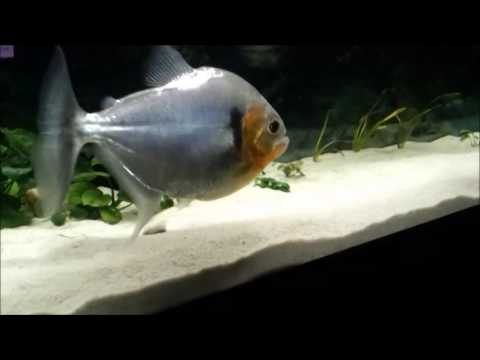Serrasalmus manueli – Manuel’s Piranha
Serrasalmus manueli was officially described in 1967 by Fernandez-Yepez and Ramírez. Their common name is Manuel’s Piranha. Juveniles are often referred to as Tiger Piranha or Green Tiger Piranha (see below).
Synonym: Pygocentrus manueli.
Description
This species is one of the largest piranha species of all, and according to the locals and fishermen can reach a length of well over 60 centimeters. However, so far, there is little evidence to support such claims: the largest known specimens to date were confirmed at about 55 centimeters.
In private aquariums this species is a very rare appearance: most of the fish that survive transport from South America are wild-caught (due to lack of captive bred species). They are extremely difficult to transport, especially larger ones. They usually have a size of between 10 and 15 centimeters, with an occasional outlier towards 20 centimeters. The largest known specimen in captivity measures about 35 centimeters, so it is still a long way from its potential maximum size.
Body Characteristics
Juveniles and sub-adult specimens are easily recognizable by a number of characteristics that they do not otherwise share with any other species: first, the body shape is very elongated, almost similar to Serrasalmus elongatus: this physique suggests that this species is a fast and agile swimmer: something confirmed by owners of this species. In addition, juveniles have a very concave head with a very long and pointed lower jaw, and extremely large eyes that give the fish a deceptively placid appearance. The flanks have a greenish tinge and sallow vertical bands that have earned this species the name Green Tiger Piranha.
As the fish gets older, the shape of the head changes from concave to convex: very large specimens look more like Pygocentrus than Serrasalmus piranhas. The eyes hardly grow along, so adult fish have better proportioned eyes than younger ones. The greenish cast and bands slowly fade, only to disappear completely.
All specimens with the exception of very young fish (less than 5-7 centimeters) have brightly colored gill covers, which vary in color from yellow through orange to deep red, and a clearly visible black spot on the shoulder, which grows larger with age.
Distinctive / unique appearances
Young/sub-adult specimens:
– Very elongated body shape (somewhat similar to S. elongatus).
– Disproportionately large silver, later slowly reddish-orange eyes.
– Light vertical bands on flanks.
– Greenish tinge on flanks.
Adults:
– Convex, Pygocentrus-like shape of head.
– Silver-gray coloration on flanks.
– Black V-shaped coloration of caudal fin: end band is bright in color.
Origin
Llanos in Venezuela, Rio Amazonas, Rio Negro in Brazil.
Diet
The diet of this large species largely corresponds to the other species of the genus Serrasalmus. That means fish (fillet , frozen or live *) , shrimp, krill , crab, mussels, worms and other insects, in some cases even dry food like pellets.
In the wild, nuts, seeds and fruits make up an important part of the daily diet, but in captivity this species accepts almost exclusively meat food.
* When feeding live fish, a number of things should be considered: First, all fish can introduce diseases and/or parasites into the aquarium, including goldfish, windes and other commonly used cold water fish as well as tropical fish. It is therefore also advisable to keep food fish in a quarantine aquarium for a week or 2, in order to ‘flush out’ the sick and weakened specimens. In addition, it should be taken into account that goldfish and close relatives are not particularly nutritious. A diet that usually consists of live fish is therefore not recommended. All the more because goldfish and other Cyprinidae (carp-like) contain hormones – so-called “Thiaminase / Vitamin B1 inhibitors” – that paralyze the production of certain growth-stimulating substances in predatory fish. A very one-sided goldfish diet can therefore lead to growth and development disorders!
It may take a while for the fish to accept prepared food: if this is the case, make sure the fish is well fed with live food and then introduce a fasting period of a week to 12 days. During this period, provide the desired prepared food while the lighting is dimmed or turned off. If it doesn’t work the first time, supplement with live food and try again. Piranhas can go without food for a number of weeks without any problems, so the fish is not in any danger during this “cure” (with the exception of specimens smaller than about 8 centimeters!).
The Aquarium
Small specimens, up to 8-10 centimeters, can be temporarily kept in aquariums of 60-80 centimeters in length. As they get bigger, a larger aquarium should be provided: up to a length of about 20-25 centimeters, an aquarium of 100-120 centimeters in length and 40-50 centimeters in depth is sufficient. Larger specimens require even larger aquariums: starting point for an aquarium tailored for life is 5 to 6 times the maximum size in aquarium length (minimum two meters), and minimum 70 centimeters in depth and height.
Temperature: 24 – 30 degrees Celsius.
pH: 5.5 – 7.5
Compatible Species
None.
Although this species can be relatively peaceful towards other fish in the aquarium, it is practically impossible to keep several specimens together: the size of aquarium required to do so is simply too large and expensive for the average hobbyist.
Breeding Serrasalmus manueli – Manuel’s Piranha
Breeding Serrasalmus manueli in captivity has not yet been successful. All fish present in the hobby are wild caught specimens
Video
Author
Jonas Hansel – Piranha-info.com (original website no longer online)
Copyright images
Jonas Hansel – Piranha-info.com (original website no longer online)










